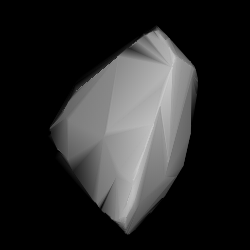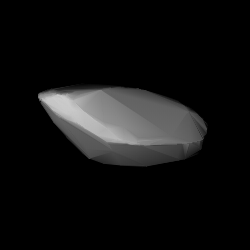Related Research Articles
821 Fanny is a dark background asteroid and slow rotator from the central regions of the asteroid belt. It was discovered on 31 March 1916, by German astronomer Max Wolf at the Heidelberg-Königstuhl State Observatory in southwest Germany. The carbonaceous C-type asteroid (Ch) has an exceptionally long rotation period of 236.6 hours and measures approximately 29 kilometers in diameter. Any reference of the asteroid's name to a person is unknown.
865 Zubaida is an elongated, stony background asteroid from the inner regions of the asteroid belt. It was discovered on 15 February 1917, by astronomer Max Wolf at the Heidelberg Observatory in southwest Germany, and given the provisional designations A917 CH and 1917 BO. The uncommon L-type asteroid has a rotation period of 11.4 hours and measures approximately 17 kilometers in diameter. It was named after Zobeide, a character in the opera Abu Hassan by Carl Maria von Weber (1786–1826).

961 Gunnie is a very dark background asteroid from the central regions of the asteroid belt, approximately 37 kilometers in diameter. It was discovered on 10 October 1921, by German astronomer Karl Reinmuth at the Heidelberg-Königstuhl State Observatory. The C/X-type asteroid has a rotation period of 21.4 hours. It was named after Gunnie Asplind, daughter of Swedish astronomer Bror Asplind (1890–1954).
1020 Arcadia, provisional designation 1924 QV, is a stony Agnia asteroid from the central regions of the asteroid belt, approximately 11 kilometers in diameter. It was discovered on 7 March 1924, by German astronomer Karl Reinmuth at the Heidelberg Observatory in Heidelberg, Germany. The asteroid was named after the Greek region of Arcadia.
1024 Hale, provisional designation A923 YO13, is a carbonaceous background asteroid from the outer regions of the asteroid belt, approximately 45 kilometers (28 miles) in diameter. The asteroid was discovered on 2 December 1923, by Belgian–American astronomer George Van Biesbroeck at the Yerkes Observatory in Wisconsin, United States. It was named for American astronomer George Ellery Hale. The dark C-type asteroid may have a rotation period of 16 hours.
1059 Mussorgskia, provisional designation 1925 OA, is a background asteroid from the central regions of the asteroid belt, approximately 25 kilometers in diameter. It was discovered on 19 July 1925, by Soviet astronomer Vladimir Albitsky at the Simeiz Observatory on the Crimean peninsula. The asteroid was named for Russian composer Modest Mussorgsky. The X- or C-type asteroid has a rotation period of 5.636 hours.

1111 Reinmuthia is a very elongated asteroid from the background population, located in the outer region of the asteroid belt. It was discovered on 11 February 1927, by German astronomer Karl Reinmuth at the Heidelberg Observatory in southwest Germany. The F-type asteroid (FX) has a short rotation period of 4.02 hours and measures approximately 40 kilometers in diameter. It was later named in honor of Karl Reinmuth, the discoverer himself.

1677 Tycho Brahe, provisional designation 1940 RO, is a stony Marian asteroid from the central region of the asteroid belt, approximately 12 kilometers in diameter. It was discovered on 6 September 1940, by Finnish astronomer Yrjö Väisälä at Turku Observatory in Southwest Finland. The common stony S-type asteroid has a short rotation period of 3.89 hours. It was later named after Tycho Brahe, one of the fathers of astronomy.
3290 Azabu, provisional designation 1973 SZ1, is a dynamical Hildian asteroid from the outermost regions of the asteroid belt, approximately 10–20 kilometers (6–10 miles) in diameter. It was discovered on 19 September 1973, by Dutch astronomers Ingrid and Cornelis van Houten at Leiden, and Tom Gehrels the Palomar Observatory. The asteroid has a rotation period of 7.67 hours. It was named after the former city district of Tokyo, Azabu.
1609 Brenda, provisional designation 1951 NL, is a stony asteroid from the central region of the asteroid belt, approximately 28 kilometers in diameter. It was discovered on 10 July 1951, by South African astronomer Ernest Johnson at the Johannesburg Observatory in South Africa, and named after his granddaughter, Brenda.
3141 Buchar, provisional designation 1984 RH, is a dark Cybele asteroid from the outermost region of the asteroid belt, approximately 36 kilometers in diameter. It was discovered on 2 September 1984, by Czech astronomer Antonín Mrkos at the Kleť Observatory. The D-type asteroid has a rotation period of 11.4 hours. It was named in memory of Czechoslovakian astronomer Emil Buchar.
1227 Geranium, provisional designation 1931 TD, is a carbonaceous background asteroid from the outer regions of the asteroid belt, approximately 46 kilometers in diameter. It was discovered on 5 October 1931, by German astronomer Karl Reinmuth at the Heidelberg-Königstuhl State Observatory. The asteroid was named for the flowering plant Geranium (cranesbills).
27270 Guidotti (provisional designation 2000 AY4) is a carbonaceous background asteroid from the inner regions of the asteroid belt, approximately 7 kilometres in diameter. It was discovered on 2 January 2000, by Italian astronomers Luciano Tesi and Alfredo Caronia at the Pistoia Mountains Astronomical Observatory in San Marcello Pistoiese, Italy. The asteroid was named after amateur astronomer Guido Guidotti.
2726 Kotelnikov, provisional designation 1979 SE9, is a stony Koronian asteroid from the outer regions of the asteroid belt, approximately 10 kilometers (6.2 miles) in diameter. It was discovered on 22 September 1979, by Soviet astronomer Nikolai Chernykh at the Crimean Astrophysical Observatory in Nauchnij on the Crimean peninsula. The S-type asteroid has a rotation period of 4.91 hours and is a suspected binary system. The asteroid was named for Soviet scientist and pioneer in radar astronomy, Vladimir Kotelnikov.
4804 Pasteur, provisional designation 1989 XC1, is a carbonaceous background asteroid from the central regions of the asteroid belt, approximately 20 kilometers in diameter. It was discovered on 2 December 1989, by Belgian astronomer Eric Elst at the ESO's La Silla Observatory in Chile. The asteroid was named after French chemist and microbiologist Louis Pasteur.

6070 Rheinland (prov. designation: 1991 XO1) is a paired Nysian asteroid from the inner regions of the asteroid belt, approximately 4.4 kilometers (2.7 miles) in diameter. It was discovered on 10 December 1991, by German astronomer Freimut Börngen at the Karl Schwarzschild Observatory in Tautenburg, Germany. The asteroid was named after the Rhineland, a region in western Germany. The stony asteroid has a rotation period of 4.27 hours.
1977 Shura, provisional designation 1970 QY, is a stony asteroid from the middle region of the asteroid belt, approximately 16 kilometers in diameter. It was discovered on 30 August 1970, by Russian astronomer Tamara Smirnova at the Crimean Astrophysical Observatory, Nauchnyj, on the Crimean peninsula. The asteroid was named for Soviet Aleksandr Kosmodemyansky.
2443 Tomeileen, provisional designation A906 BJ, is a stony Eoan asteroid from the outer regions of the asteroid belt, approximately 32 kilometers in diameter. It was discovered on 24 January 1906, by German astronomer Max Wolf at the Heidelberg-Königstuhl State Observatory in Heidelberg, Germany. The S-type asteroid was named after the parents of British astronomer Brian G. Marsden. It has a rotation period of 3.97 hours.
4608 Wodehouse, provisional designation 1988 BW3, is a background asteroid and suspected trojan of Ceres from the inner regions of the asteroid belt, approximately 8 kilometers in diameter. It was discovered on 19 January 1988, by Belgian astronomer Henri Debehogne at ESO's La Silla Observatory in northern Chile. The asteroid was named after English writer P. G. Wodehouse.
10046 Creighton, provisional designation 1986 JC, is a carbonaceous background asteroid from the inner regions of the asteroid belt, approximately 10 kilometers in diameter. It was discovered on 2 May 1986, by astronomers with the International Near-Earth Asteroid Survey (INAS) at Palomar Observatory, California, in the United States. The C-type asteroid has a rotation period of 6.57 hours. It was named after American architect James M. Creighton.
References
- 1 2 3 4 5 6 7 "2301 Whitford (1965 WJ)". Minor Planet Center. Retrieved 19 March 2018.
- 1 2 3 4 "JPL Small-Body Database Browser: 2301 Whitford (1965 WJ)" (2018-01-27 last obs.). Jet Propulsion Laboratory . Retrieved 19 March 2018.
- 1 2 3 4 5 6 7 8 "LCDB Data for (2301) Whitford". Asteroid Lightcurve Database (LCDB). Retrieved 19 March 2018.
- 1 2 "Asteroid 2301 Whitford – Proper Elements". AstDyS-2, Asteroids – Dynamic Site. Retrieved 29 October 2019.
- 1 2 3 4 Masiero, Joseph R.; Mainzer, A. K.; Grav, T.; Bauer, J. M.; Cutri, R. M.; Nugent, C.; et al. (November 2012). "Preliminary Analysis of WISE/NEOWISE 3-Band Cryogenic and Post-cryogenic Observations of Main Belt Asteroids". The Astrophysical Journal Letters. 759 (1): 5. arXiv: 1209.5794 . Bibcode:2012ApJ...759L...8M. doi:10.1088/2041-8205/759/1/L8 . Retrieved 19 March 2018.
- 1 2 3 4 Usui, Fumihiko; Kuroda, Daisuke; Müller, Thomas G.; Hasegawa, Sunao; Ishiguro, Masateru; Ootsubo, Takafumi; et al. (October 2011). "Asteroid Catalog Using Akari: AKARI/IRC Mid-Infrared Asteroid Survey". Publications of the Astronomical Society of Japan. 63 (5): 1117–1138. Bibcode:2011PASJ...63.1117U. doi:10.1093/pasj/63.5.1117. (online, AcuA catalog p. 153)
- 1 2 3 Waszczak, Adam; Chang, Chan-Kao; Ofek, Eran O.; Laher, Russ; Masci, Frank; Levitan, David; et al. (September 2015). "Asteroid Light Curves from the Palomar Transient Factory Survey: Rotation Periods and Phase Functions from Sparse Photometry". The Astronomical Journal. 150 (3): 35. arXiv: 1504.04041 . Bibcode:2015AJ....150...75W. doi:10.1088/0004-6256/150/3/75 . Retrieved 19 March 2018.
- 1 2 Veres, Peter; Jedicke, Robert; Fitzsimmons, Alan; Denneau, Larry; Granvik, Mikael; Bolin, Bryce; et al. (November 2015). "Absolute magnitudes and slope parameters for 250,000 asteroids observed by Pan-STARRS PS1 - Preliminary results". Icarus. 261: 34–47. arXiv: 1506.00762 . Bibcode:2015Icar..261...34V. doi:10.1016/j.icarus.2015.08.007 . Retrieved 19 March 2018.
- ↑ "MPC/MPO/MPS Archive". Minor Planet Center. Retrieved 19 March 2018.